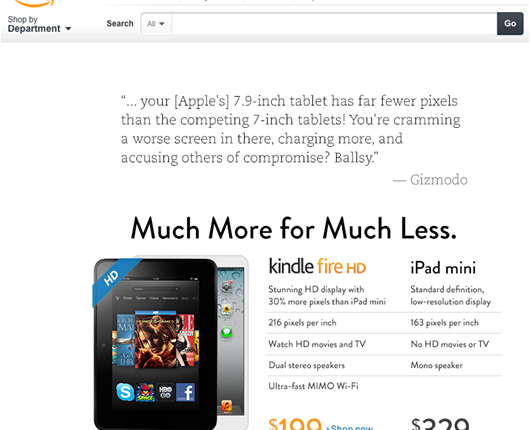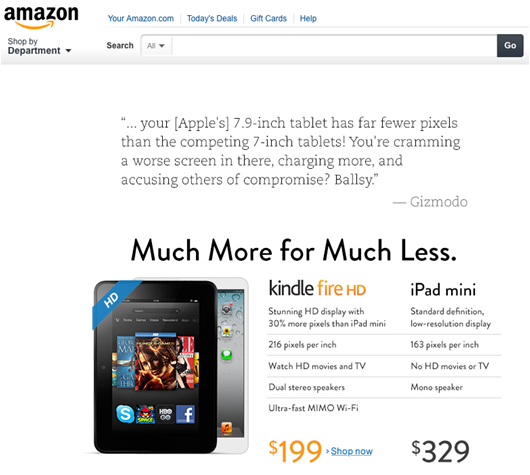In any aspect of marketing, it all comes down to value proposition. A marketer’s job is to communicate the value of a product or service to a potential customer.
Even companies with big advertising budgets can lose sight of the necessity and responsibility of every marketer to convey value – they may actually be more susceptible to it.
For instance, ever since Apple’s renaissance, pretty much everyone wrote Microsoft off as the poor (and old) man’s Apple. Even they seemed to, with its not cool enough to be a Mac ad campaign a few years ago.
With all of the recent talk about Windows 8, and the debut of the company’s first tablet, Surface (set up to be an iPad competitor), a Cinderella-story comeback seemed possible. Maybe not likely – but possible.
When Microsoft announced it wasn’t going with one of its usual three agencies (Crispin Porter & Bogusky, Deutsch or Razorfish) to produce an ad for the Surface — instead choosing the relatively unknown 22-year-old Caleb Slain, who incredibly made Internet Explorer cool again with this ad — I thought Microsoft might pull it off.
However, instead of spotlighting the sleek and cool but extremely product-focused video that Slain created, the one I see on a constant loop is the incredibly distracting (and after the tenth view, annoying) dancing people and clicking noise ad, as seen below:
Let me make this disclaimer before we go any farther: I liked the ad, but I hated the sacrifice of value proposition it made in favor of the cool factor – because it is possible to have both. Just ask Microsoft’s competition, Apple.
“The click” is the highlighted aspect of the ad, an external keyboard that attaches to the tablet. Other than that, I’m just not sure what is supposed to motivate me to purchase the Surface. The krumping school girls? Maybe the ability to leap through mid-air while clicking into place the keyboard that comes with it?
“I think the only people who have a legitimate chance of going to the store and purchasing are people who are sold on Microsoft already,” says Adam Lapp, Associate Director of Optimization, MECLABS, adding, “The ad doesn’t do anything to distinguish itself from the iPad, and you don’t even know cost. It does nothing to motivate you to learn more.”
As you design your own ads, consider these three steps to create an ad with a strong value proposition.
Step #1. Picture the customer’s buying process
A big mistake of Microsoft’s, according to Adam, is not considering the customer’s buying process and anticipating the questions and needs they will have.
“A lot of times people create marketing material without considering the customer’s buying process,” Adam says. “[Consumers] don’t go straight to Microsoft – they go to Samsung, they go to Apple, they search, and then they make their decision. If you’re not mimicking that journey with your own strategic planning, then you are going to fail.”
With the recent ads for the Samsung Galaxy S III showing value proposition and the “cool” factor so well, by directly pointing out aspects in which it is better than its competitor (Apple), Samsung decisively threw its hat into the ring, and made a big impression doing so.
Amazon also recently made a very clear play for the iPad customers by leveraging its highly trafficked homepage to show the differences between the iPad mini and its product, the Kindle Fire.
With all of this competition in the tablet world, it kind of feels as if the Jets and Sharks gangs of West Side Story were suddenly dropped into south L.A. – fun dance moves and a catchy beat don’t get you taken seriously.
Adam took the video to the MECLABS optimization team for its input. The analysis of the ad all encircled one question: Where is the value proposition? Some feedback included:
- There is confusion over what, exactly, is being sold (the tablet, or just the keyboard?)
- The point of “simplicity” is not apparent to the average consumer watching
- Microsoft is promoting convenience (with the kickstand, attached keyboard) but there is nothing about specs, speed or quality
- Credibility: Do consumers trust Microsoft to provide a quality product?
Clarity was the biggest issue with this ad, and can be a problem with any marketer’s value proposition. Addressing the needs that will arise in the customer’s buying process will strengthen the value proposition as well as the consumer’s view of the product or service.
Step #2. Focus on strong selling points
The keyboard is not a strong enough point to get people to change their minds and switch from Apple to Microsoft, Adam says. It may be a selling point, but certainly not enough to carry its entire advertising campaign.
“It’s easy to fall into that company-centric communication versus customer-centric communication. You’ve made this product, and you’re proud of yourself, but you’re not paying attention to what the customer needs,” Adam says.
It’s easy to get caught up in a great idea. But certain questions must be asked to ensure that you are really delivering essential value to the group you have identified as your consumers:
- What do my customers need, and how does this product provide it to them?
- Where do I stand out when compared to my competition?
- How do I display those needs in a way that will resonate with my audience?
Step #3. Combine the value proposition with a great idea (and team)
Eventually, the suggestions of the MECLABS optimization team devolved into some pretty random but interesting ideas to improve the Surface commercial:
- Cut the dancing in half to have Lee Corso and Chris Fowler from College Game Day cut in and talk about how it is the future of computing.
- Bring in a Lord of the Rings theme with the catch phrase, “One Tablet to Rule Them All” – not a bad idea, since apparently LOTR can sell just about anything.
- The last, and possibly greatest suggestion, was that the ad was sadly lacking puppies.
This exemplifies two things: how quickly brainstorming can go in an unexpected direction, and, more importantly, how creative and fun a group of talented people can be. All of the above suggestions are the beginnings of ideas that, given some time and finesse, could make good ads.
And, that’s what Microsoft’s Surface ad is – a fun idea, but just “good” without any clear value proposition. What makes any appeal to consumers great is the due diligence of making sure value proposition is a priority.
Honest communication on the team is essential to mastering this combination, according to Adam.
“It’s easier to agree with something than to disagree with it – that goes back to hiring and how you structure your team,” he says.
Adam says MECLABS has had success with creating a team environment where “no one presents a finished product or launches a test before it’s vetted by the entire group.”
Related Resources:
Value Proposition: How to use social media to help discover why customer should buy from you
Microsoft Snubs Ad Agencies In Favor of This 22-Year-Old For Surface Tablet Launch Video (via Business Insider)
Customer Value: The 4 essential levels of value propositions
Marketing Research Chart: Top-rated tactics for developing value propositions that resonate and convert (via MarketingSherpa)
Marketing Optimization: 4 steps to discovering your value proposition and boosting conversion (via MarketingSherpa)





Great post guys. I was thinking (and said to my wife) the exact same thing during the ad. Here they are with a completely revolutionary new tablet – and the ad makes it seem like a joke!
And I would imagine they aren’t even split-testing the ads…. :o/
Jeremy Reeves
http://www.JeremyReeves.com
Terrible post guys. A 60 second ad spot on TV isn’t meant to do all the selling and present all the value you suggest. Talk about “clarity”, what the heck does your little Microscope graphic at the front of your blogs name represent? Can you clarify?
All a 60 second ad spot is supposed to do is grab your attention, and get the potential buyer to want to know more which is exactly why I found my way to your blog post in the first place.
This little 60 second TV spot conveyed 8 different and unique ideas that will most certainly peek the interest of the average consumer. It doesn’t matter if it is the Krump girls (which by itself is creating a buz) with all searches related to them leading to more info about Microsoft, the old folks kissing ( a 2 second message that conveys the idea that all generations can use the surface), or the jumping guys (that conveys ease of use and portability)
That is all it is supposed to do – peek interest.
You want to blog about annoying and useless commercials? Blog about the stupid cadillac commercial with two guys driving down twisty mountain roads at high speeds to show off the braking and handling system of a $60,000 Chevy look-a-like. The second time that ad came on TV, I changed channels.
I’ll bet the surface commercial stays on all the way through, every time.
Isitall
@Isitall
Let me start off by saying that this post was my opinion of the commercial supported by feedback from the Research Analysts at MECLABS. That being said, when it comes to presenting value, a 60 second ad spot is more time than it seems. Commercials are rolling off the line every day that accomplish the tasks of grabbing attention while also selling and presenting value. Samsung’s Galaxy SIII, as I mentioned in the post, does all three fantastically.
Now, as I disclaimed in the post, I do not think the ad is terrible in any way, I simply was disappointed by what I saw as a lack of value with a product that, once I did the research for writing this post, was so ripe with it. I had to search a lot farther than I would otherwise have been willing to, especially with all of the other tablets available whose value is more clear to me.
I did come to see all of the points that you make, with what the krumping girls, older couple and jumping guys represent in the commercial, but on first view I was more confused by the seemingly random and hectic presentation than I was with thinking about the deeper metaphor to the product.
Granted, this was just my own experience as a consumer. This blog post was merely meant to take that experience and use it to highlight the overarching marketing principle of conveying value to your consumers. Perhaps metaphors are overrated all around.
I will take your suggestion about the Cadillac commercial under advisement, but thank you for your feedback about the Surface post – obviously, my consumer experience is not everyone’s, so it is valuable to get the opposite point of view.